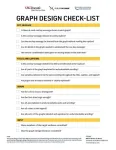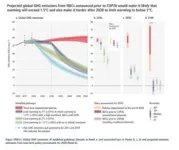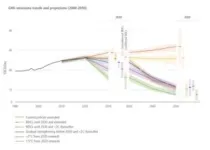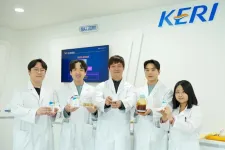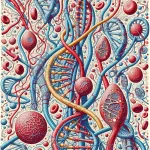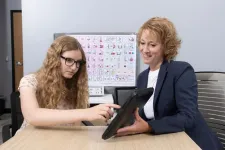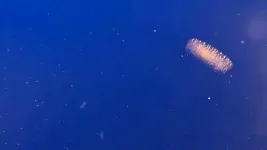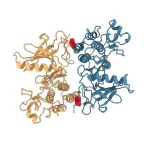(Press-News.org) When the “hockey stick” graph, which illustrated a steep increase in global temperatures, was published in 1998, it reshaped the world’s understanding of climate change. A quarter-century later, with climate change now wreaking havoc around the world, graphics depicting global warming are more important than ever to inform policymaking.
However, a recent USC-led study reveals that some graphics developed for reports by the Intergovernmental Panel on Climate Change (IPCC) are too complex, even for the intended audiences of policymakers and practitioners.
Researchers recommend limiting each graphic, which the IPCC refers to as “figures,” and its title to one key message. The study produced a detailed checklist to improve the design of graphics that target policymakers and practitioners.
“Because climate experts want to be accurate and complete, they tend to cram too much information into their graphics,” said Wändi Bruine de Bruin, the study’s lead author and Provost Professor of Public Policy, Psychology and Behavioral Sciences at the USC Dornsife College of Letters, Arts and Sciences and the USC Price School of Public Policy. “A graphic is worth a thousand words, but only if it clearly communicates one key message.”
The study was published in Climatic Change on March 19 titled Improving figures for climate change communications: Insights from interviews with international policymakers and practitioners.
This is the second study in which USC researchers collaborated with the UN Foundation to improve the effectiveness of climate change communication. The first study, which looked at language comprehension, was published on Aug. 21, 2021, in a special edition of the journal Climatic Change titled “Climate Change Communication and the IPCC.”
"This research sheds new light on how policymakers and practitioners engage with, interpret, and utilize IPCC report graphics,” said Pete Ogden, Vice President of Climate and Environment at the United Nations Foundation (UNF). “This will be a valuable tool not only for the IPCC as it embarks on its new report cycle, but for anyone engaged in the vital work of making climate science clear and accessible.”
Global collaboration produces results
In collaboration with the UNF, USC Dornsife Public Exchange convened a team of USC behavioral scientists to interview 20 policymakers and practitioners from the IPCC’s and UNF’s global network.
Participants viewed three figures drafted for the Second Order Draft Summary for Policymakers from Working Group III of the IPCC’s Sixth Assessment Report. Interviews typically reach saturation — revealing no new topics — after talking to 15-20 participants. This study achieved saturation by the 15th interview.
The study’s participants came from developed economies with robust climate science research capabilities, like the United States and Germany, and developing economies, like Chad. Participants representing various sectors were asked to rate how easy or hard it was to understand the three graphs.
One participant remarked, “My first impression is: too much information.” Another questioned, “So as a policymaker, what is the message?”
Graphics first, explanation later
The researchers noted that the graphics appeared to be designed primarily for scientists without considering a broader audience. This can cause graphics to be too technical and complex. Readers often engage with graphics first and might share them out of context. Indeed, more than half of the participants said they tended to review graphics before reading the main text of a report.
Simplicity shouldn’t compromise accuracy
The three graphics assessed were “GHG [greenhouse gas] emissions trends and projections,” “Feasibility challenges” and “Breakdown of average investment needs until 2030.” “GHG emissions trends and projections” was the only graph revised for inclusion in the IPCC’s report. The other graphs were not.
Specifically, the graphic illustrating GHG emissions — emissions causing climate change — drew mixed responses because of its dense presentation of data. One participant suggested dividing it into two or three graphs for better clarity.
In response, the IPCC revised the graph’s format and title to reflect the key message.
Similarly, even participants familiar with IPCC’s graphs found a graph depicting the need for climate investment confusing. An occasional user of the IPCC graphs said, “You’ve got to read the fine print, and you shouldn’t have to read the fine print. I mean, these graphs should stand on their own.”
A challenge for IPCC authors lies in simplifying graphs without sacrificing accuracy or details, however.
Clarity is key
Participants also struggled with graphs that had unclear titles — as was the case with the GHG emissions graph — ambiguous labels, indistinct color schemes, complex scientific jargon and captions that read like technical footnotes. They wanted clarification about specific technical terms and acronyms.
The Checklist
To improve climate change communication, the team developed a checklist for designing more effective graphs for IPCC reports and other communications. The checklist recommends following graph design best practices and including audience feedback to improve climate change communication.
“We are excited that our study provides a user-friendly checklist for the IPCC to create graphs that are more accessible,” said Monica Dean, Climate and Sustainability Practice Director at USC Dornsife Public Exchange.
END
Climate change graphics are important, so make them simple
USC study: Climate change graphics should convey one message and target a broad audience to be effective; Study is second collaboration with UN Foundation on improving science communications
2024-03-19
ELSE PRESS RELEASES FROM THIS DATE:
Rising rates of head and facial injuries from exercise and weightlifting
2024-03-19
Waltham — March 18, 2024 — Numbers of craniofacial injuries related to exercise and weightlifting have increased sharply over the past decade, reports a study in The Journal of Craniofacial Surgery. The journal is published in the Lippincott portfolio by Wolters Kluwer.
"Incidence of craniofacial injury significantly increased between 2013 and 2022, illuminating the need for better education and risk mitigation strategies," according to the new research by Rohan Mangal, MSc, and colleagues of University of Miami. Rates of exercise-related head and facial injuries appear higher for men than women, and ...
A breakthrough in solid-state electrolytes for all-solid-state batteries: Twice the quality with streamlined processes
2024-03-19
Korea Electrotechnology Research Institute (KERI) has reached a significant milestone with the publication of a groundbreaking study in a globally esteemed journal, marking a crucial stride toward the commercialization of all-solid-state batteries, free from the inherent risks of explosion and fire.
Dr. Park Jun-woo of the KERI Next-Generation Battery Research Center and Sung Junghwan (student researcher at the UST KERI Campus) have successfully engineered a revolutionary technology. This technology, focused on the "size-controlled ...
Circulating tumor DNA levels predict treatment outcomes for patients with gastroesophageal cancer treated with a novel immunotherapy combination
2024-03-19
Monitoring levels of DNA shed by tumors and circulating in the bloodstream could help doctors accurately assess how gastroesophageal cancers are responding to treatment, and potentially predict future prognosis, suggests a new study led by researchers at the Johns Hopkins Kimmel Cancer Center and its Bloomberg~Kimmel Institute for Cancer Immunotherapy.
The study tracked minimal residual disease (the amount of cancer left following treatment) by analyzing circulating tumor DNA (ctDNA), showing how these ...
Association between miR-492 rs2289030 G>C and susceptibility to neuroblastoma in Chinese children from Jiangsu province
2024-03-19
Neuroblastoma is a heterogeneous solid tumor that originates extracranially from neuroblasts. Previous research has demonstrated that miR-492 polymorphisms can contribute to cancer susceptibility. However, their specific involvement in susceptibility to neuroblastoma has yet to be fully clarified.
Background and objectives
Neuroblastoma is a heterogeneous solid tumor that originates extracranially from neuroblasts. Previous research has demonstrated that miR-492 polymorphisms can contribute to cancer susceptibility. However, their specific involvement in susceptibility to neuroblastoma has yet to be fully clarified.
In this study, we focused on miRNA-492, which has been reported to ...
Choosing over the counter drugs for COVID 19? It’s complicated
2024-03-19
COVID-19 illness may include symptoms such as a sore throat, fever, cough and fatigue. In January, the United States Centers for Disease Control and Prevention (CDC) issued its most recent guidelines for the use of over the counter (OTC) drugs for COVID-19. Specifically, its guidelines state that most people with COVID-19 have mild illness and can recover at home while treating symptoms with OTC medicines such as acetaminophen (Tylenol) or ibuprofen (Motrin, Advil).
Researchers from Florida Atlantic University’s Schmidt College ...
Binghamton University’s Speech and Language Pathology program receives accreditation candidacy
2024-03-19
BINGHAMTON, N.Y. -- The new Master of Science in Speech and Language Pathology (MS-SLP) program at Binghamton University’s Decker College of Nursing and Health Sciences has achieved a significant milestone toward accreditation by the Council on Academic Accreditation in Audiology and Speech-Language Pathology (CAA). The council recently awarded the program accreditation candidacy for five years, beginning Feb. 1, 2024, and running through Jan. 31, 2029.
The decision was based on a thorough review of all candidacy materials for the program, including the application, site visit report and the program’s ...
Characterizing salps as predators of marine microbes
2024-03-19
A huge fraction of global flows of carbon and other nutrients passes through marine microbes, little is known about their causes of death—information that in many cases determines where those nutrients will go. Recent work on microbial death via viral lysis and protistan predation is helping close the gap, but there remains a missing source of microbial mortality. Anne Thompson and colleagues explore the role played by salps, pelagic tunicates that feed by pumping seawater through mucous mesh nets, filtering out and capturing particles such as preferred microbes. Salps send ...
Four PPPL researchers featured in the Physics of Plasmas Early Career Collection
2024-03-19
The U.S. Department of Energy’s Princeton Plasma Physics Laboratory (PPPL) made a strong showing in this year’s Early Career Collection from the scientific journal Physics of Plasmas. The collection represents the top papers from all areas of plasma physics research authored by people who defended their dissertations less than five years before the journal article was submitted.
“The first authors of the pieces in the 2023 Early Career Collection have made a notable contribution to the field of plasma and show significant promise. I look forward to ...
Does AI help or hurt human radiologists’ performance? It depends on the doctor
2024-03-19
One of the most touted promises of medical artificial intelligence tools is their ability to augment human clinicians’ performance by helping them interpret images such as X-rays and CT scans with greater precision to make more accurate diagnoses.
But the benefits of using AI tools on image interpretation appear to vary from clinician to clinician, according to new research led by investigators at Harvard Medical School, working with colleagues at MIT and Stanford.
The study findings suggest that individual clinician differences shape the interaction between human ...
Scientists identify Achilles heel of lung cancer protein
2024-03-19
Researchers have shown for the first time that a crucial interface in a protein that drives cancer growth could act as a target for more effective treatments.
The study was led by the Science and Technology Facilities Council (STFC) Central Laser Facility (CLF) and used advanced laser imaging techniques to identify structural details of a mutated protein which help it to evade drugs that target it.
It is published (19/03/2024) in the journal, Nature Communications and lays the groundwork for future research into ...
LAST 30 PRESS RELEASES:
Manta rays create mobile ecosystems, study finds
Study: Mixed results in using lipoic acid to treat progressive multiple sclerosis
Norbert Holtkamp appointed director of Fermi National Accelerator Laboratory
New agentic AI platform accelerates advanced optics design
Biologists discover neurons use physical signals — not electricity — to stabilize communication
Researchers discover that a hormone can access the brain by hitchhiking
University of Oklahoma researcher awarded funding to pursue AI-powered material design
Exploring how the visual system recovers following injury
Support for parents with infants at pediatric check-ups leads to better reading and math skills in elementary school
Kids’ behavioral health is a growing share of family health costs
Day & night: Cancer disrupts the brain’s natural rhythm
COVID-19 vaccination significantly reduces risk to pregnant women and baby
The role of vaccination in maternal and perinatal outcomes associated with COVID-19 in pregnancy
Mayo Clinic smartwatch system helps parents shorten and defuse children's severe tantrums early
Behavioral health spending spikes to 40% of all children’s health expenditures, nearly doubling in a decade
Digital cognitive behavioral treatment for generalized anxiety disorder
Expenditures for pediatric behavioral health care over time and estimated family financial burden
Air conditioning in nursing homes and mortality during extreme heat
The Alps to lose a record number of glaciers in the next decade
What makes a good proton conductor?
New science reporting guide published for journalists in Bulgaria
New international study reveals major survival gaps among children with cancer
New science reporting guide published for journalists in Turkey
Scientists develop a smarter mRNA therapy that knows which cells to target
Neuroanatomy-informed brain–machine hybrid intelligence for robust acoustic target detection
Eight SwRI hydrogen projects funded by ENERGYWERX
The Lundquist Institute and its start-up company Vitalex Biosciences Announces Strategic Advancement of Second-Generation fungal Vaccine VXV-01 through Phase 1 Trials under $40 Million Competitive Con
Fine particles in pollution are associated with early signs of autoimmune disease
Review article | Towards a Global Ground-Based Earth Observatory (GGBEO): Leveraging existing systems and networks
Penn and UMich create world’s smallest programmable, autonomous robots
[Press-News.org] Climate change graphics are important, so make them simpleUSC study: Climate change graphics should convey one message and target a broad audience to be effective; Study is second collaboration with UN Foundation on improving science communications
